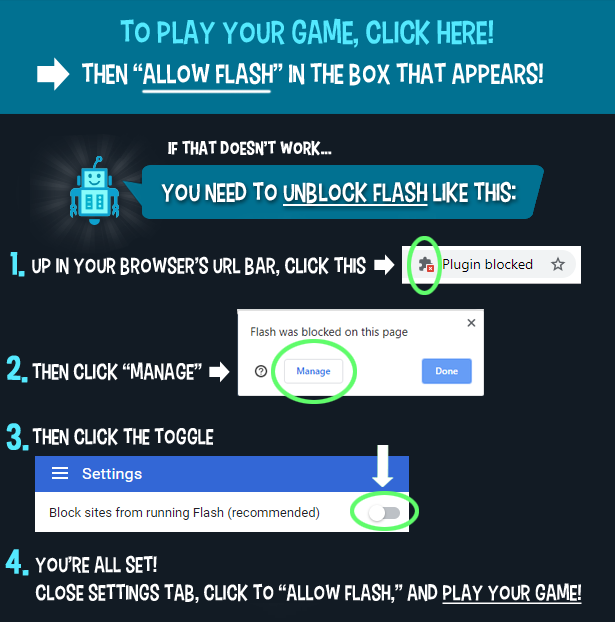Sorry... this game is not playable in your browser.


This Flash game is currently not playable in your browser, but we're working on a fix! Come back regularly to see if it's ready to play.
Most browsers no longer support Flash. Affected games are indicated by






Backgammon
Game content reviewed byJonathan Keefer
Backgammon Instructions
The goal of Backgammon is to move all of your checker pieces off the board and into one of the boxes on the right side. In order to do that, you’ll need to move all your pieces into your home board first. The color you chose at the start of the game will determine which way you move each turn. Red pieces move clockwise to get to their home board on the upper right hand corner. White pieces move counterclockwise with their goal at the bottom right.
Tap on the dice to roll. If the left die shows a higher number when playing against the computer, you get to move first. When playing with a friend, the left die is for player 1 and the right die is for player 2. The player who moves first must move the amount of spaces shown on the dice. You can move your pieces according to the number shown each individual die or add up the sum of the dice and move forward that amount. If both dice show the same number, then you get an extra two moves.
You can move your checkers onto any point with one or fewer enemy pieces. If you move to a point with an enemy piece, it will be removed from the board and your opponent will have to use a roll to put it back on the board. Once you get all of your checkers to the correct corner, you can continue to roll to remove pieces off the board. Remove all of your pieces from the board before your opponent in order to win!
Backgammon Tips & Tricks
Homeward bound. Keep your sights set on that home corner. You can’t remove your checkers from the board until you get all of them on the home points. If you find that luck is on your side and you keep getting high-numbered rolls, you can use the “Running Game” strategy and race all your pieces home as fast as you can before your opponent does.
Knock ‘em out. Another good offensive strategy is to attack your opponent’s single pieces as much as you can. Sending your opponent’s pieces to the middle bar means they’ll have to use their next roll to bring it back in the game. If they can’t move the barred checker the amount shown on the dice, then they forfeit the turn. The more turns they use to revive benched pieces, the more opportunities you get to rush your pieces back home.
Two’s company. Your opponent can only land on empty points or points with one single piece. In order to stop them from knocking out your checkers, try to move your checkers in tandem so as to not leave any alone on a single point. If you double up your checkers, it will give your opponent one less place to land and will keep all your pieces on the board.
Create anchor points. If possible, leave an anchor point of two or more checkers in your opponent’s home board. This will give you a place to land if a checker is ever sent to the bar. You can also fill up your home board with two or more pieces on each point, leaving your opponent with no way of getting a benched checker back on the board.
What You Learn From Playing Backgammon
Playing Backgammon can help teach basic addition in counting as well as more complicated themes like probability and luck. The game helps players determine the odds of their checkers making it to the home board or being captured by the opponent’s piece. Players can also learn how to not rely on pure luck by using strategies to overcome a bad roll.
The goal of Backgammon is to move all of your checker pieces off the board and into one of the boxes on the right side. In order to do that, you’ll need to move all your pieces into your home board first. The color you chose at the start of the game will determine which way you move each turn. Red pieces move clockwise to get to their home board on the upper right hand corner. White pieces move counterclockwise with their goal at the bottom right.
Click on the dice to roll. If the left die shows a higher number when playing against the computer, you get to move first. When playing with a friend, the left die is for player 1 and the right die is for player 2. The player who moves first must move the amount of spaces shown on the dice. You can move your pieces according to the number shown each individual die or add up the sum of the dice and move forward that amount. If both dice show the same number, then you get an extra two moves.
You can move your checkers onto any point with one or fewer enemy pieces. If you move to a point with an enemy piece, it will be removed from the board and your opponent will have to use a roll to put it back on the board. Once you get all of your checkers to the correct corner, you can continue to roll to remove pieces off the board. Remove all of your pieces from the board before your opponent in order to win!
Backgammon Tips & Tricks
Homeward bound. Keep your sights set on that home corner. You can’t remove your checkers from the board until you get all of them on the home points. If you find that luck is on your side and you keep getting high-numbered rolls, you can use the “Running Game” strategy and race all your pieces home as fast as you can before your opponent does.
Knock ‘em out. Another good offensive strategy is to attack your opponent’s single pieces as much as you can. Sending your opponent’s pieces to the middle bar means they’ll have to use their next roll to bring it back in the game. If they can’t move the barred checker the amount shown on the dice, then they forfeit the turn. The more turns they use to revive benched pieces, the more opportunities you get to rush your pieces back home.
Two’s company. Your opponent can only land on empty points or points with one single piece. In order to stop them from knocking out your checkers, try to move your checkers in tandem so as to not leave any alone on a single point. If you double up your checkers, it will give your opponent one less place to land and will keep all your pieces on the board.
Create anchor points. If possible, leave an anchor point of two or more checkers in your opponent’s home board. This will give you a place to land if a checker is ever sent to the bar. You can also fill up your home board with two or more pieces on each point, leaving your opponent with no way of getting a benched checker back on the board.
What You Learn From Playing Backgammon
Playing Backgammon can help teach basic addition in counting as well as more complicated themes like probability and luck. The game helps players determine the odds of their checkers making it to the home board or being captured by the opponent’s piece. Players can also learn how to not rely on pure luck by using strategies to overcome a bad roll.
Just a moment while your advertisement loads
Advertisement
Just a moment while your advertisement loads
Advertisement
Backgammon
Game content reviewed byJonathan Keefer
Backgammon Instructions
The goal of Backgammon is to move all of your checker pieces off the board and into one of the boxes on the right side. In order to do that, you’ll need to move all your pieces into your home board first. The color you chose at the start of the game will determine which way you move each turn. Red pieces move clockwise to get to their home board on the upper right hand corner. White pieces move counterclockwise with their goal at the bottom right.
Tap on the dice to roll. If the left die shows a higher number when playing against the computer, you get to move first. When playing with a friend, the left die is for player 1 and the right die is for player 2. The player who moves first must move the amount of spaces shown on the dice. You can move your pieces according to the number shown each individual die or add up the sum of the dice and move forward that amount. If both dice show the same number, then you get an extra two moves.
You can move your checkers onto any point with one or fewer enemy pieces. If you move to a point with an enemy piece, it will be removed from the board and your opponent will have to use a roll to put it back on the board. Once you get all of your checkers to the correct corner, you can continue to roll to remove pieces off the board. Remove all of your pieces from the board before your opponent in order to win!
Backgammon Tips & Tricks
Homeward bound. Keep your sights set on that home corner. You can’t remove your checkers from the board until you get all of them on the home points. If you find that luck is on your side and you keep getting high-numbered rolls, you can use the “Running Game” strategy and race all your pieces home as fast as you can before your opponent does.
Knock ‘em out. Another good offensive strategy is to attack your opponent’s single pieces as much as you can. Sending your opponent’s pieces to the middle bar means they’ll have to use their next roll to bring it back in the game. If they can’t move the barred checker the amount shown on the dice, then they forfeit the turn. The more turns they use to revive benched pieces, the more opportunities you get to rush your pieces back home.
Two’s company. Your opponent can only land on empty points or points with one single piece. In order to stop them from knocking out your checkers, try to move your checkers in tandem so as to not leave any alone on a single point. If you double up your checkers, it will give your opponent one less place to land and will keep all your pieces on the board.
Create anchor points. If possible, leave an anchor point of two or more checkers in your opponent’s home board. This will give you a place to land if a checker is ever sent to the bar. You can also fill up your home board with two or more pieces on each point, leaving your opponent with no way of getting a benched checker back on the board.
What You Learn From Playing Backgammon
Playing Backgammon can help teach basic addition in counting as well as more complicated themes like probability and luck. The game helps players determine the odds of their checkers making it to the home board or being captured by the opponent’s piece. Players can also learn how to not rely on pure luck by using strategies to overcome a bad roll.
The goal of Backgammon is to move all of your checker pieces off the board and into one of the boxes on the right side. In order to do that, you’ll need to move all your pieces into your home board first. The color you chose at the start of the game will determine which way you move each turn. Red pieces move clockwise to get to their home board on the upper right hand corner. White pieces move counterclockwise with their goal at the bottom right.
Click on the dice to roll. If the left die shows a higher number when playing against the computer, you get to move first. When playing with a friend, the left die is for player 1 and the right die is for player 2. The player who moves first must move the amount of spaces shown on the dice. You can move your pieces according to the number shown each individual die or add up the sum of the dice and move forward that amount. If both dice show the same number, then you get an extra two moves.
You can move your checkers onto any point with one or fewer enemy pieces. If you move to a point with an enemy piece, it will be removed from the board and your opponent will have to use a roll to put it back on the board. Once you get all of your checkers to the correct corner, you can continue to roll to remove pieces off the board. Remove all of your pieces from the board before your opponent in order to win!
Backgammon Tips & Tricks
Homeward bound. Keep your sights set on that home corner. You can’t remove your checkers from the board until you get all of them on the home points. If you find that luck is on your side and you keep getting high-numbered rolls, you can use the “Running Game” strategy and race all your pieces home as fast as you can before your opponent does.
Knock ‘em out. Another good offensive strategy is to attack your opponent’s single pieces as much as you can. Sending your opponent’s pieces to the middle bar means they’ll have to use their next roll to bring it back in the game. If they can’t move the barred checker the amount shown on the dice, then they forfeit the turn. The more turns they use to revive benched pieces, the more opportunities you get to rush your pieces back home.
Two’s company. Your opponent can only land on empty points or points with one single piece. In order to stop them from knocking out your checkers, try to move your checkers in tandem so as to not leave any alone on a single point. If you double up your checkers, it will give your opponent one less place to land and will keep all your pieces on the board.
Create anchor points. If possible, leave an anchor point of two or more checkers in your opponent’s home board. This will give you a place to land if a checker is ever sent to the bar. You can also fill up your home board with two or more pieces on each point, leaving your opponent with no way of getting a benched checker back on the board.
What You Learn From Playing Backgammon
Playing Backgammon can help teach basic addition in counting as well as more complicated themes like probability and luck. The game helps players determine the odds of their checkers making it to the home board or being captured by the opponent’s piece. Players can also learn how to not rely on pure luck by using strategies to overcome a bad roll.
Votes



















